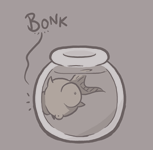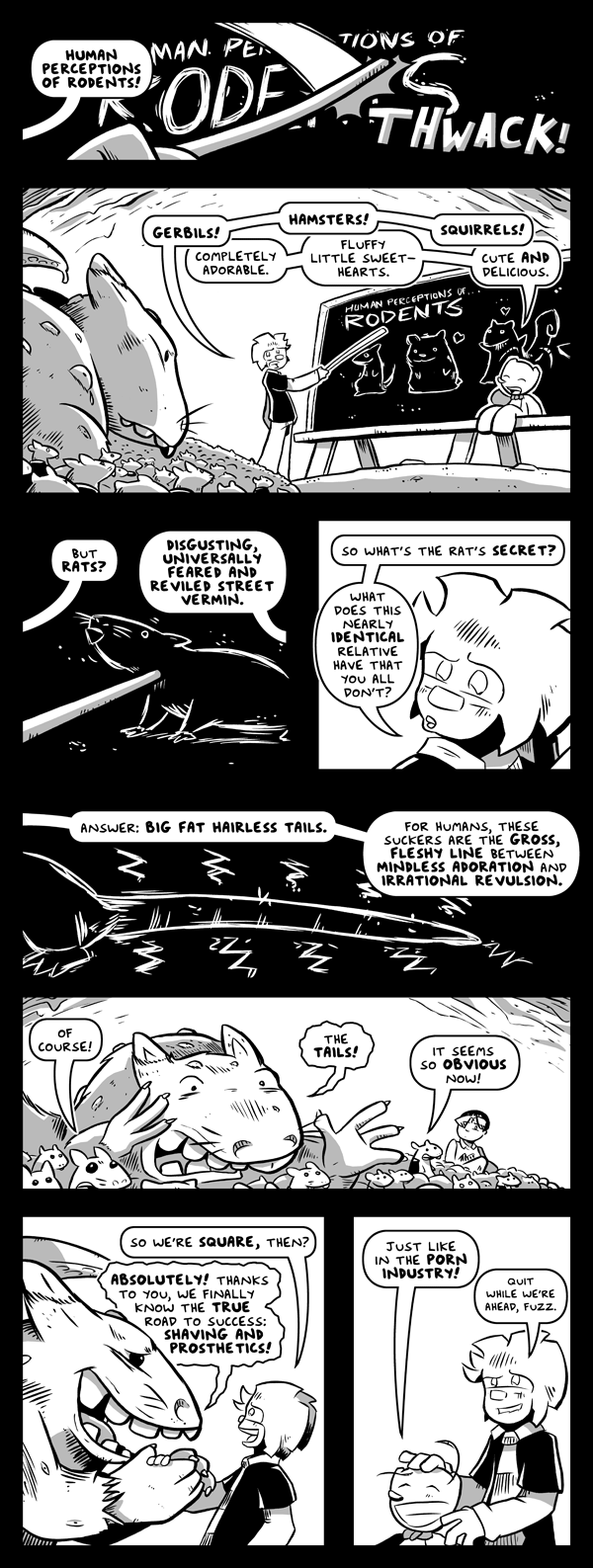Rat race
Obligatory disclaimer: As pets, rats are actually much friendlier, smarter, and more social than most other rodents! They're practically the dogs of the caged pet universe. They really don't deserve their unfortunate rep... not even as plague carriers. (It was fleas that carried it. The plague was actually as fatal to the rats as it was to humans.)
So there, I said it. Rats get the raw deal. Angry emails from passionate rat owners... totally dodged!
-Sam Logan
Discuss on the forum
Sam and Fuzzy Q & A: Plaid Edition
Got a question you want answered? Just drop me an email with "Q & A" in the subject line!
"Ok, so Sam's sister. Sam's hair obviously looks like Sonic the Hedgehog's, so does that mean his sister's hair was inspired by Knuckles the Echidna? Is she rougher than the rest of them?" -Michael
She isn't that much rougher. You should see her walkin' through valleys cryin' pumpkin in the alley.
You can kind of tell how ancient each member of my cast is by how much they resemble Sonic the Hedgehog characters. Back in 1992, that was about all I knew how to draw. Susan was created for one of the oldest iterations of Sam and Fuzzy -- one of the ones I drew as a kid, long before I'd even discovered the internet.
But when she did finally appear in the web version, I kept relatively close to her original design... the one I made back when I thought giving a female character Knuckles hair and a huge square nose was a great idea. I was a cool kid!
"Did Sam lose weight in the newest comics? He seems skinnier." -Serafim
Sam's weight has kind of fluctuated over the course of the comic. In the oldest comics, he was rail-thin, but he put a lot of weight on in the year he was working as a roadie for Noosehead. (I'm sure finishing off The Eliminator didn't help, either.)
Ever since then, I've been trying to draw him as though he's been whittling it back down very, very gradually. It just seems more realistic than changing it dramatically all at once... and as I'm sure you've guessed, maintaining complete realism in my comic about ninjas and mutant rodents is very important to me.
"Straight up deathmatch, Fuzzy vs. Pintsize. Who wins?" -Michael
As you might expect, Jeph and I have opposite opinions on this matter. But we've both drawn many, many con sketches that investigate the subject.
"I've been reading back through your archives and I just have to ask. What is up with all the references to Robert Boyle? And it's not just fuzzy
mentioning him here and here, he's also mentioned in comic 873. So? What's up with that?" -Patrick
I'm glad you asked, Patrick! Here is the deal with Robert Boyle.
Robert Boyle was a natural philosopher, chemist, physicist, inventor, and gentleman scientist, also noted for his writings in theology. He is best known for the formulation of Boyle's law. Although his research and personal philosophy clearly has its roots in the alchemical tradition, he is largely regarded today as the first modern chemist, and therefore one of the founders of modern chemistry. Among his works, The Sceptical Chymist is seen as a cornerstone book in the field of chemistry.
Robert Boyle was born in Lismore Castle, in County Waterford, Ireland, the seventh son and fourteenth child of Richard Boyle, 1st Earl of Cork. Richard Boyle had arrived in Ireland in 1588 as an entrepreneur, and had amassed enormous landholdings by the time Robert was born. While still a child, Robert learned to speak Latin, Greek and French. He was not yet eight years old when, following the death of his mother, he was sent to Eton College in England, at which his father's friend, Sir Henry Wotton, was then provost. After spending over three years at Eton, Robert traveled abroad with a French tutor. They visited Italy in 1641, and remained in Florence during the winter of that year, studying the "paradoxes of the great star-gazer" Galileo Galilei — Galileo was elderly, but still alive in Florence in 1641.
Boyle returned to England from the Continent in mid 1644 with a keen interest in science. His father had died the previous year and had left him the manor of Stalbridge in Dorset, together with some estates in Ireland. From that time, he devoted his life to scientific research, and soon took a prominent place in the band of inquirers, known as the "Invisible College", who devoted themselves to the cultivation of the "new philosophy". They met frequently in London, often at Gresham College; some of the members also had meetings at Oxford, and in that city Boyle went to reside in 1654. Reading in 1657 of Otto von Guericke's air-pump, he set himself with the assistance of Robert Hooke to devise improvements in its construction, and with the result, the "machina Boyleana" or "Pneumatical Engine", finished in 1659, he began a series of experiments on the properties of air. An inscription can be found on the wall of University College, Oxford in the High Street at Oxford (now the location of the Shelley Memorial), marking the spot where Cross Hall stood until the early 1800s. It was here that Boyle rented rooms from the wealthy apothecary who owned the Hall.
An account of Boyle's work with the air pump was published in 1660 under the title New Experiments Physico-Mechanicall, Touching the Spring of the Air, and its Effects.... Among the critics of the views put forward in this book was a Jesuit, Franciscus Linus (1595–1675), and it was while answering his objections that Boyle made his first mention of the law that the volume of a gas varies inversely to the pressure of the gas, which among English-speaking people is usually called after his name.
However, the person that originally formulated the hypothesis was Henry Power in 1661. Boyle included a reference to a paper written by Power, but mistakenly attributed it to Richard Townley. In continental Europe the hypothesis is sometimes attributed to Edme Mariotte, although he did not publish it until 1676 and was likely aware of Boyle's work at the time. In 1663 the Invisible College became the Royal Society of London for the Improvement of Natural Knowledge, and the charter of incorporation granted by Charles II of England, named Boyle a member of the council. In 1680 he was elected president of the society, but declined the honour from a scruple about oaths.
It was during his time at Oxford that Boyle was a Chevalier. The Chevaliers are thought to have been established by royal order a few years before Boyle's time at Oxford. The period of Boyle's residence was marked by the reactionary actions of the victorious parliamentarian forces, consequently this period marked the most secretive period of Chevalier movements and thus little is known about Boyle's involvement beyond his membership.
In 1668 he left Oxford for London where he resided at the house of his sister, Lady Ranelagh, in Pall Mall.
In 1689 his health, never very strong, began to fail seriously and he gradually withdrew from his public engagements, ceasing his communications to the Royal Society, and advertising his desire to be excused from receiving guests, "unless upon occasions very extraordinary", on Tuesday and Friday forenoon, and Wednesday and Saturday afternoon. In the leisure thus gained he wished to "recruit his spirits, range his papers", and prepare some important chemical investigations which he proposed to leave "as a kind of Hermetic legacy to the studious disciples of that art", but of which he did not make known the nature. His health became still worse in 1691, and he died on 30 December that year, just a week after that of the sister with whom he had lived for more than twenty years. He was buried in the churchyard of St Martin's in the Fields, his funeral sermon being preached by his friend Bishop Gilbert Burnet. In his will, Boyle endowed a series of Lectures which came to be known as the Boyle Lectures.
And that's the deal with Robert Boyle.
Have a nice easter, everyone!
-Sam Logan
Mystery man
One of the things I really like about Emerald City is how receptive the crowd their seems to be to new comics. Compared to a lot of the other shows I go to, the number of existing Sam and Fuzzy readers who swing by the booth is relatively low. (I got very good at quickly explaining who "that first character" is on the My Skills are Varied t-shirt!) But what ECCC does have is a lot of people who are honestly interested in comics, and who are actively looking for new ones to read.
More than at any other con, people will stop for a good couple of minutes, read a few pages of my books, flip through my entire display portfolio, and ask for the site URL on it so they can check it out later. Several of the existing Sam and Fuzzy readers I met this year were people who had only discovered the comic by attending last year's show.
I love science fiction movies and videogames as much as the next guy. But still, it's a real pleasure to attend an event where the focus is comics, and where the audience is so eager to learn about new work. Between ECCC and the Webcomics Weekend, I am feeling pretty spoiled!
-Sam Logan
- Bad Machinery
- Boxer Hockey
- Broodhollow
- Clique Refresh
- Dawn of Time
- Dead Winter
- Dinosaur Comics
- Dr McNinja
- Dumbing of Age
- Filibuster
- Gastrophobia
- Gunnerkrigg Court
- Gunshow
- Hijinks Ensue
- Octopus Pie
- Ornery Boy
- Overcompensating
- Questionable Content
- Scenes from a Multiverse
- A Softer World
- Wasted Talent
- Weregeek
- Wondermark









